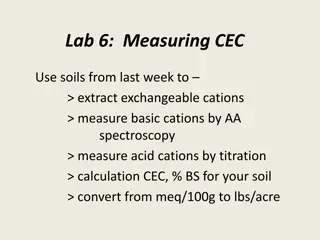Detector Building
Teams will construct a durable Oxidation Reduction Potential (ORP) probe to measure voltage and NaCl concentrations in water samples. Participants will complete a written test on the event's principles and theories. The competition involves building the device using microcontrollers, sensors, and di
2 views • 15 slides
Understanding Survey Data Analysis in SAS: Methods and Applications
Explore the nuances of survey data analysis in SAS, covering topics such as populations and samples, complex survey samples, stratified sampling, and more. Learn how to ensure representativeness in sampling and optimize precision of estimates in survey studies.
0 views • 31 slides
Practical Aspects of Taking Cervical Samples: Guidance for Sample Takers
This guidance covers practical aspects of taking cervical samples, including preparing the environment, essential equipment, checking patient identity, and effective communication skills for sample takers to provide information and answer questions. It emphasizes the importance of a warm, well-lit,
7 views • 49 slides
Understanding Non-Probability Sampling Methods
Non-probability sampling methods involve selecting samples based on subjective judgment rather than random selection. Types include convenience sampling, quota sampling, judgmental (purposive) sampling, and snowball sampling. Convenience sampling picks easily available samples, quota sampling select
2 views • 7 slides
Systematic Analysis of Real Samples in Analytical Chemistry
This analysis covers the systematic process involved in analyzing real samples, including sampling, sample preservation, and sample preparation. It discusses the importance of accurate sampling in obtaining information about various substances, such as solids, liquids, gases, and biological material
0 views • 54 slides
Introduction to Sampling in Statistics
Sampling in statistics involves selecting a subset of individuals from a population to gather information, as it is often impractical to study the entire population. This method helps in estimating population characteristics, although it comes with inherent sampling errors. Parameters represent popu
2 views • 24 slides
Mastering PTE Academic Speaking_ Retell Lecture Samples and Strategies
Wrapping Up\n\nMastering the Retell Lecture task in the PTE Academic Speaking section is all about practice and strategy. By honing your listening skills, structuring your responses effectively, and using the provided samples as a guide, you\u2019ll
0 views • 3 slides
Spectrophotometric Determination of Cr and Mn in Steel Samples
This experiment aims to determine the concentrations of manganese and chromium in steel samples by converting Cr3+ and Mn2+ ions to light-absorbing forms, followed by spectrophotometric measurements at specific wavelengths. Steel samples are oxidized, dissolved, and further oxidized to form dichroma
0 views • 10 slides
Effective Memo Samples for Parking and Break Time Policies
These memo samples address parking concerns due to limited space and break time violations in the workplace. Daniel Smith and Anne Henderson effectively communicate the need for cooperation and adherence to the specified rules to ensure smooth operations.
0 views • 5 slides
Depth Profile Analysis of Fusion-Relevant Samples Using LIBS Technique
Analysis of fusion-relevant samples through Laser-Induced Breakdown Spectroscopy (LIBS) is conducted at Comenius University. The study compares picosecond (ps) and nanosecond (ns) regimes in depth profiling and quantification of tungsten-based coatings and other fusion materials. The research also i
0 views • 8 slides
Understanding Sampling Methods and Errors in Research
Sampling is crucial in research to draw conclusions about a population. Various methods like simple random sampling, stratified sampling, and systematic sampling help in selecting representative samples. Sampling error arises due to differences between sample and population values, while bias leads
0 views • 12 slides
ELECTRA: Pre-Training Text Encoders as Discriminators
Efficiently learning an encoder that classifies token replacements accurately using ELECTRA method, which involves replacing some input tokens with samples from a generator instead of masking. The key idea is to train a text encoder to distinguish input tokens from negative samples, resulting in bet
0 views • 12 slides
Bacteriological Analysis of Drinking Water by MPN Method in Microbiology Class III
This study focuses on the bacteriological analysis of drinking water using the Most Probable Number (MPN) method in a microbiology class. The MPN method involves enumerating and identifying bacteria in drinking water samples through a series of tests including presumptive, confirmed, and completed t
0 views • 13 slides
Sampling Methods and Requirements for Water and Wastewater Analysis
The collection of water and wastewater samples is crucial for accurate analysis and monitoring. Understanding the reasons for sampling, different methods, and the importance of sample preparation is essential for obtaining reliable results. Planning sampling, meeting specific requirements, and selec
6 views • 22 slides
Understanding Basic Concepts in Statistics
This content covers fundamental concepts in statistics such as populations, samples, models, and probability distributions. It explains the differences between populations and samples, the importance of models in describing populations, and discusses various distributions like the normal and Poisson
0 views • 42 slides
Software Engineering Design Principles and Concepts
The chapter discusses the essential principles and concepts in software design, highlighting the four key design models - data design, architectural design, interface design, and component-level design. It emphasizes the importance of traceability to the analysis model, minimizing the gap between so
0 views • 36 slides
Understanding Independent Samples t-Test in Statistical Analysis
The independent samples t-test is used to compare means in a between-groups design where each participant is in only one condition. It involves sets of participant scores that are independent, meaning they are completely unrelated to each other. This test helps to determine if there is a significant
1 views • 32 slides
Solving the Murder of Mrs. Mary Smith: An Interactive Investigation Experience
Dive into a thrilling murder mystery as you help solve the case of Mrs. Mary Smith's tragic death. Explore evidence rooms, analyze fingerprints, hair samples, soil samples, and chemical details to unravel the mystery. Follow the clues, watch videos, and conduct interviews to uncover the truth behind
5 views • 17 slides
Navigating Statistical Inference Challenges in Small Samples
In small samples, understanding the sampling distribution of estimators is crucial for valid inference, even when assumptions are violated. This involves careful consideration of normality assumptions, handling non-linear hypotheses, and computing standard errors for various statistics. As demonstra
0 views • 19 slides
gNB Positioning Measurement Requirements Discussion at 3GPP TSG-RAN WG4 Meeting
Discussion at the 3GPP TSG-RAN WG4 meeting #98bis-e focused on gNB positioning measurement requirements, including beam sweeping, gNB accuracy requirements, samples for gNB accuracy, RoAoA side conditions, and SRS-RSRP measurement accuracy requirements. The meeting addressed various candidate option
1 views • 14 slides
Comparative Study of Soil Samples from Gottigere Lake and Madiwala Lake
This study compares the soil samples from Gottigere Lake and Madiwala Lake in Bangalore, India, analyzing macronutrients, micronutrients, and indicator species to assess pollution levels. The research aims to contribute to wetland conservation and ecosystem-based climate change adaptation.
0 views • 32 slides
Limitations of Deep Learning in Adversarial Settings
Deep learning, particularly deep neural networks (DNNs), has revolutionized machine learning with its high accuracy rates. However, in adversarial settings, adversaries can manipulate DNNs by crafting adversarial samples to force misclassification. Such attacks pose risks in various applications, in
0 views • 38 slides
Agglutination Testing in Laboratory Medicine
Agglutination testing is a common method used in laboratory medicine to detect the presence and amount of antigens or antibodies in patient samples. It involves the use of carrier particles such as latex, RBCs, charcoal, and protein A of Staph aureus. The testing process includes qualitative and qua
0 views • 18 slides
Developing Effective Reading Work Samples
Creating reading work samples involves steps like identifying a topic, analyzing passages, drafting tasks, formatting, administering, scoring, and revising tasks. Considerations include text complexity, high student interest, and grade-level appropriateness. Text complexity is assessed quantitativel
0 views • 15 slides
Formal and Informal Invitation Guidelines and Samples
Learn about the basic features, formats, and marking scheme for formal and informal invitations. Explore samples for different occasions such as dinner parties and school events. Be inspired to create your own invitations with proper content and expression.
0 views • 20 slides
Comparison of Wet-Wipe and Tape Lift Methods for Sampling Wildfire Smoke Residues
This research study compared the performance of wet-wipe and tape lift sampling methods for evaluating the impact of surface char from wildfire smoke residues. The study involved sampling 48 houses in Southern California affected by different wildfires, utilizing side-by-side replicate samples colle
0 views • 56 slides
Understanding Random Sampling in Probabilistic System Analysis
In the field of statistical inference, random sampling plays a crucial role in drawing conclusions about populations based on representative samples. This lecture by Dr. Erwin Sitompul at President University delves into the concepts of sampling distributions, unbiased sampling procedures, and impor
0 views • 23 slides
Practical Guide to Fuzzing Programs with AFL
Explore the process of fuzzing a real program using American Fuzzy Lop (AFL) with NASM, a popular Netwide Assembler. Learn how to obtain AFL and NASM, create test samples, minimize samples, start the fuzzer, and receive tips for successful fuzzing. Embrace the journey that may take days, weeks, or e
2 views • 8 slides
Understanding Non-Probability Sampling Methods
Non-probability sampling involves selecting samples based on subjective judgment rather than random selection, leading to a lack of equal chances for all population members to participate. Various types include convenience sampling, quota sampling, judgmental sampling, and snowball sampling. Conveni
1 views • 7 slides
Exploring Design Inspiration and Elements in Costume and Fashion Design
Dive into the world of costume and fashion design through a visual journey of finding design inspiration, understanding the design process, emphasizing originality, and exploring different sources of creativity. Discover how technology, art, food, history, architecture, and nature can spark innovati
0 views • 45 slides
Comprehensive Soil Cation Exchange Capacity (CEC) Measurement Lab Procedure
This lab exercise focuses on measuring CEC using soil samples, extracting exchangeable cations, analyzing basic cations through AA spectroscopy, titrating acid cations, calculating CEC and base saturation percentage for the soil, and converting cation measurements from meq/100g to lbs/acre. The step
0 views • 9 slides
Material Design: Combining Classic Design Principles with Technological Innovation
Material Design is a design language that combines traditional design principles with the possibilities offered by technology and science. It emphasizes visual language, classic design elements, and innovation to create delightful user experiences. The Material Metaphor, Imagery, Typography, Color,
0 views • 34 slides
Comprehensive Guide to System Design Components and Techniques
System design involves the detailed planning and identification of components in an information system, aiming to provide users with a general understanding of the new system. This process includes techniques like flowcharts, prototyping, and component design, covering aspects such as output design,
0 views • 24 slides
Understanding Basic Concepts in Software Design
Software design involves transforming customer requirements into a form suitable for implementation, with activities categorized into preliminary and detailed design stages. High-level design focuses on module identification and control relationships, while detailed design entails defining data stru
1 views • 24 slides
Guide and Design Samples for Creating Voter Guide Inserts
Ensure voter engagement by utilizing the provided design samples and guide for creating informative inserts for voter guides. Learn how to design and customize inserts for your jurisdiction, including important deadlines and options for returning your ballot.
0 views • 5 slides
Study on the Thermal and Chemical Properties of Polymer-Cement Composites
The study investigates the resistance of polymer-cement composites to thermal stress and chemical attacks such as acidic and high CO2 environments. Results show similar color changes in control cement and polymer-cement composites after thermal stress, with the latter maintaining compressive strengt
0 views • 5 slides
Analytical Toxicology: Techniques and Sample Analysis in Clinical Toxicology
Analytical toxicology involves the observation, identification, and measurement of foreign compounds in biological and other samples, such as urine, blood, stomach contents, nails, hair, and DNA. Various techniques are used to isolate and identify drugs and poisons present in these samples. This fie
0 views • 12 slides
Utilizing Different Samples for Diagnostic Testing in Medicine
The practice of diagnostic testing in medicine goes beyond blood and stool samples. Gathering urine samples, for example, allows healthcare providers to assess various health aspects, such as kidney function, urinary tract infections, diabetes, and more. By examining the color, clarity, odor, densit
0 views • 21 slides
Quality Assurance Sampling Protocols for Flower Lots under WAC 314-55-101
Quality assurance sampling protocols for flower lots under WAC 314-55-101 dictate that at least 4g of flower lot samples are required, with procedures outlining the deduction of four separate samples from different quadrants of the lot to ensure representativeness. The WSLCB Traceability system enfo
0 views • 4 slides
Ensuring Chain of Evidence Integrity in Cargo Sampling
The chain of evidence is crucial in cargo sampling to establish a direct link between declared cargo, samples taken, and analyst's findings. This involves physical measures like identification of goods and representative samples, as well as documentary measures such as examination accounts and labor
0 views • 13 slides







































